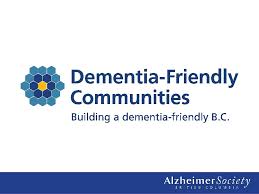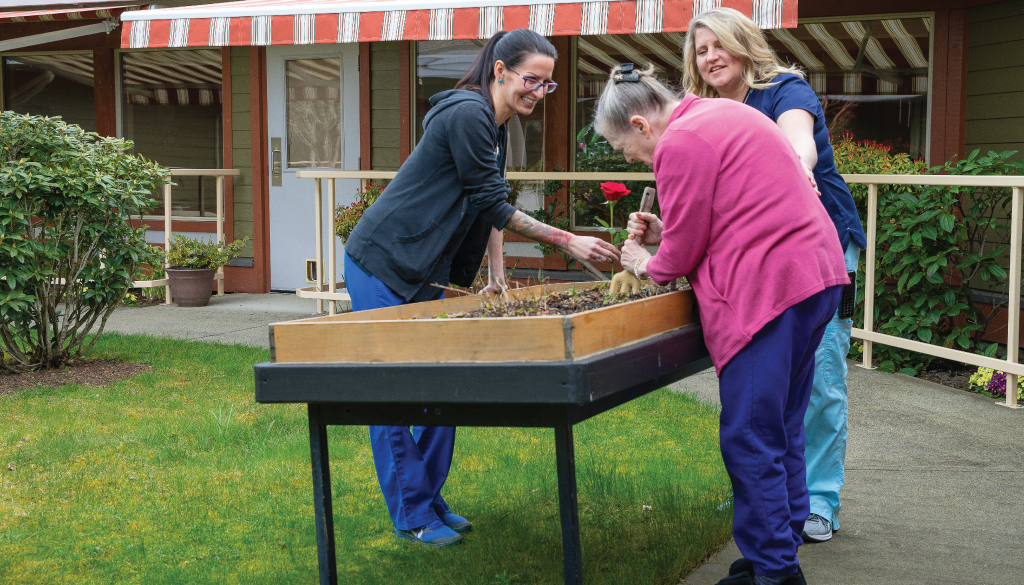Currently there are about 750,000 Canadians living with Alzheimer’s disease and other forms of dementia.[i] As outlined by the Canadian Institute for Health Information (CIHI), about 1 in 4 seniors age 85 or older[ii] have been diagnosed with dementia and the number of Canadians living with dementia is expected to increase by over 65 percent over the next 15 years.[iii]
Dementia is a particularly pressing matter in long-term care as over 60 percent of residents have some form of dementia, an overall trend which has been steadily increasing over time.[iv] People living with dementia in long-term care deserve to be supported in settings that are appropriate, safe, and positioned to help ensure the best quality of life possible: truly “dementia-friendly” environments.
 What makes a dementia-friendly care home? The BC Care Providers Association and Alzheimer Society of B.C., in partnership with Simon Fraser University (SFU), are exploring this critical question. This collaborative project will examine what other jurisdictions in Canada and internationally have done, or are doing, to develop dementia-friendly criteria or guidelines in long-term care.
What makes a dementia-friendly care home? The BC Care Providers Association and Alzheimer Society of B.C., in partnership with Simon Fraser University (SFU), are exploring this critical question. This collaborative project will examine what other jurisdictions in Canada and internationally have done, or are doing, to develop dementia-friendly criteria or guidelines in long-term care.
Current Research Findings
Dementia-friendly care homes generally have three key elements: 1) they intentionally utilize dementia-friendly design, 2) they put emphasis on ensuring that staff have appropriate dementia education and training, and 3) they are intended to feel home-like, rather than institutional.
Creating an appropriate physical environment within care homes is critical for people living with dementia. A 2017 study noted that supportive environments can have a number of positive effects on people living with dementia. These include helping people stay oriented, improving daily activities, promoting autonomy and meaningful activity, reducing anxiety, agitation and falls as well as providing better person-centred care.[v] To achieve these positive outcomes, it may in some cases require updating the physical infrastructure of care homes. Modern care home designs and increased privacy, for example, are important for people living with dementia, who can become upset when they do not have the personal space they need.[vi]
people living with dementia. These include helping people stay oriented, improving daily activities, promoting autonomy and meaningful activity, reducing anxiety, agitation and falls as well as providing better person-centred care.[v] To achieve these positive outcomes, it may in some cases require updating the physical infrastructure of care homes. Modern care home designs and increased privacy, for example, are important for people living with dementia, who can become upset when they do not have the personal space they need.[vi]
The Ontario Long-Term Care Association identified that over half of Ontario’s older care homes – many in small communities or rural locations – currently do not meet the most recent design standards. For example, older homes have three or four-bed wards and cramped living spaces, which do not reflect best practices, particularly for those who live with dementia.[vii] Like Ontario, B.C. also has many care homes that are outdated and unable to provide the most appropriate dementia care.
Dementia-friendly care homes also seek to create environments that are distinctive, safe, and familiar to seniors.[viii] This includes ensuring that areas are well-lit, avoiding reflective and slippery floor surfaces, and providing easy-to-use furniture and distinctive landmarks to assist with navigation.[ix]
Along with changes to the physical environment, another fundamental element of making care homes more dementia friendly is looking at ways staff engage or interact with the people they are supporting. This can be achieved in a variety of ways including adopting a gentle persuasive approach (GPA) to dementia care or implementing new care models such as dementia villages[x] and the butterfly care model[xi]. Organizations such as Safe Care BC[xii] and the Alzheimer Society of B.C. currently offer courses (e.g. Creating Connections,[xiii] [xiv] Building a Strong Foundation for Dementia Care) based on the care approaches or techniques practiced in these models. While these models vary in scope, common features are that they are often organized more as smaller household models and promote the value of staff building relationships with people living with dementia.
Recent literature has shown that people living with dementia experience better quality of care in home-like, clustered accommodation models.[xv] In particular, home-like, clustered domestic models of care are associated with better quality of care, specifically in regards to providing access to the outdoors and flexibility of care.[xvi] Earlier research from Australia has also found that home-like models, which consist of smaller groups of up to fifteen residents, are delivering better outcomes for a comparable cost.[xvii] For example, people living in home-like settings were less likely to be admitted to hospital or transferred to an emergency department and were 52 percent less likely to be prescribed a potentially inappropriate medication.[xviii]
Next Steps
BCCPA first discussed the idea of developing dementia-friendly care home criteria in its 2016 White Paper, Sustainability and Innovation: Exploring Options for Improving B.C.’s Continuing Care Sector, where it advocated that, in partnership with relevant stakeholders including care providers, health authorities and the Alzheimer Society of B.C., the provincial government should explore establishing a dementia-friendly program in which a designation could be provided to care homes that have made specific redesign changes to accommodate people living with dementia and/or where dementia training has been provided to staff.[xix]
Along with advocating for investments for training, education and resources to improve dementia care province-wide, BCCPA has more recently advocated for the creation of a designated provincial infrastructure fund to address the need for immediate renovations required by care homes, including in part to make existing care homes more dementia-friendly.[xx] The Canadian Association of Long Term Care (CALTC), which BCCPA is a member of, is also advocating for the federal government to invest in rebuilding long-term care homes to meet current design standards and the needs of today’s seniors, especially those living with dementia.[xxi] Likewise, it is also CALTC’s hope that any new National Dementia Strategy being developed by the federal government address these physical infrastructure and other investments as a means of providing seniors living with dementia a higher quality of life.[xxii]
 This project also builds on the very important work that the Alzheimer Society of B.C. has done through its Dementia-Friendly Communities initiative. Through this program the Society works closely with municipalities, professional groups, corporations and individuals to reduce stigma and remove barriers to support people living with dementia to participate fully in their communities and continue to enjoy the activities that are meaningful to them.[xxiii]
This project also builds on the very important work that the Alzheimer Society of B.C. has done through its Dementia-Friendly Communities initiative. Through this program the Society works closely with municipalities, professional groups, corporations and individuals to reduce stigma and remove barriers to support people living with dementia to participate fully in their communities and continue to enjoy the activities that are meaningful to them.[xxiii]
The results of the literature review will be used to begin a broader consultation process which will include a dementia-friendly care home forum which will bring stakeholders together to inform the development of criteria for B.C. In addition to establishing a set of criteria and principles, the project may also explore the challenges as well as pros and cons of developing a dementia-friendly care home program or designation in the B.C. context. Likewise, it is expected that the work will assist current and future care homes in using or implementing promising practices to become more dementia-friendly.
Ultimately, developing criteria or approaches to make care homes more dementia friendly is an area the Alzheimer Society of B.C. and BCCPA believe should be explored further. With many more people living with dementia entering long term care, it is now more important than ever to ensure that they are cared for in an appropriate and safe environment as well as to help ensure the best quality of life possible in their remaining years.
END NOTES
[i] Alzheimer Society of Canada. A new way of looking at the impact of dementia in Canada. Toronto. 2012. Accessed at: http://alzheimer.ca/en/cornwall/Awareness/A-new-way-of-looking-at-dementia
[ii] Canadian Institute for Health Information. Dementia in Canada. June 2018. Accessed at: https://www.cihi.ca/en/dementia-in-canada
[iii] Canadian Institute for Health Information (CIHI). Health Care in Canada, 2011: A Focus on Seniors and Aging. Ottawa. November 2014. Accessed at: https://secure.cihi.ca/free_products/HCIC_2011_seniors_report_en.pdf.
[iv] BC Ministry of Health. Residential Care Staffing Review. March 2017. Accessed at: http://www.health.gov.bc.ca/library/publications/year/2017/residential-care-staffing-review.pdf
[v] The Influence of the Physical Environment on Residents With Dementia in Long-Term Care Settings: A Review of the Empirical Literature. Gerontologist 2017, Vol 0, No. 0, 1-13. Habib Chaudhury, Heather Cooke et al. Accessed at: https://www.researchgate.net/publication/314514461_The_Influence_of_the_Physical_Environment_on_Residents_With_Dementia_in_Long-Term_Care_Settings_A_Review_of_the_Empirical_Literature
[vi] Canadian Association for Long Term Care. Caring for Canada’s Seniors: Recommendations for meeting the needs of an aging population. February 2017. Accessed at: https://www.oltca.com/OLTCA/Documents/Reports/CaringForCanadasSeniors_CALTC.PDF
[vii] BUILDING resident-centered long-term care, now and for THE FUTURE. Ontario Long Term Care Association. January 2015. Ontario Long Term Care Association Pre-Budget Submission to the Ontario Government 2015/2016. Accessed at: https://www.oltca.com/oltca/Documents/Reports/PreBudgetSubmission2015-2016.pdf
[viii] Housing Learning & Improvement Network. At a Glance: a Checklist for Developing Dementia Friendly Communities. June 2012. Accessed at: https://www.housinglin.org.uk/_assets/resources/housing/support_materials/viewpoints/viewpoint25_ataglance.pdf
[ix] Housing Learning & Improvement Network. At a Glance: a Checklist for Developing Dementia Friendly Communities. June 2012. Accessed at: https://www.housinglin.org.uk/_assets/resources/housing/support_materials/viewpoints/viewpoint25_ataglance.pdf
[x] BCCPA. OP-ED: Exploring Dementia Villages and Other Care Models in Canada. 2015. Accessed at http://safecarebc.ca/2015/10/08/op-ed-exploring-dementia-villages-and-other-care-models-in-canada/
[xi] BCCPA. The Butterfly Effect: Changing Dementia Care in British Columbia. October 18, 2017. Accessed at: https://bccare.ca/2017/10/the-butterfly-effect-changing-dementia-care-in-british-columbia/
[xii] Established in 2013, SafeCare BC is an industry funded, non-profit association working to ensure injury free, safe working conditions for continuing care workers in B.C. SafeCare strives to be the industry leader in advancing injury prevention and safety training for long-term care and home support workers. For further information see: http://safecarebc.ca/
[xiii] In 2014, SafeCare BC and the Alzheimer Society of B.C. established the ‘Creating Connections: Working with People Living with Dementia’ workshop which has now been delivered to over 600 care providers who work with people with dementia. As part of the workshop care workers gain a better understand Alzheimer’s disease and other dementias, receive key tips for communication, and learn how to be creative in dealing with some of the behaviours common among persons with dementia. The information is also presented within the context of “person-centred care”. For further information see: https://bccare.ca/2015/01/dementia-care-workshop-creating-connections/ and https://bccare.ca/2016/06/safecare-bc-alzheimer-society-b-c-expand-agreement-offer-dementia-education/
[xiv] Creating Connections was also identified in CIHI’s Dementia in Canada (June 2018) report noting that British Columbia’s Continuing Care Health and Safety Association, SafeCare BC and the Alzheimer Society of B.C. partnered to bring dementia care training to staff in the province’s continuing care sector. The goal was to improve quality of resident care and enhance staff safety by using person-centred care approaches. For further information see: https://www.cihi.ca/en/dementia-in-canada/dementia-across-the-health-system/dementia-in-long-term-care
[xv] Aged Care Insite. Residents with dementia back home-like model of care: study. Dallas Bastian. September 5, 2018. Accessed at: https://www.agedcareinsite.com.au/2018/09/residents-with-dementia-back-home-like-model-of-care-study/
[xvi] International Journal for Quality in Health Care. Clustered domestic model of residential care is associated with better consumer rated quality of care. Emmanuel S. Gnanamanickam et. Al. August 2018. Accessed at: https://doi.org/10.1093/intqhc/mzy181
[xvii] Aged Care Insite. Home-like model of care “a no brainer”: study reveals benefits. Dallas Bastian. June 2018. Accessed at: https://www.agedcareinsite.com.au/2018/06/home-like-model-of-care-a-no-brainer-study-reveals-benefits/
[xviii] Medical Journal of Australia. Clustered domestic residential aged care in Australia: fewer hospitalizations and better quality of life. Suzanne M Dyer et al. June 2018. Accessed at: https://www.mja.com.au/journal/2018/208/10/clustered-domestic-residential-aged-care-australia-fewer-hospitalisations-and
[xix] BCCPA. Sustainability and Innovation: Exploring Options For Improving B.C.’s Continuing Care Sector. May 2016. Accessed at: https://bccare.ca/wp-content/uploads/BCCPA_part_2_HR-1.pdf
[xx] BCCPA. 2019 Budget Submission. Charting a New Course for B.C.’s Continuing Care Sector. October 2018.
[xxi] Canadian Association of Long Term Care. Improving Seniors Care in Canada. October 2018. Accessed at: https://caltc.ca/wordpress/wp-content/uploads/2018/11/CALTC-budget-submission-ONLINE.pdf
[xxii] Government of Canada Hosts National Dementia Conference: Inspiring and Informing a National Dementia Strategy. May 14, 2018. Accessed at: https://www.canada.ca/en/public-health/news/2018/05/government-of-canada-hosts-national-dementia-conference-inspiring-and-informing-a-national-dementia-strategy.html
[xxiii] Dementia-friendly communities. Alzheimer’s Society of UK. Accessed at: http://www.alzheimers.org.uk/site/scripts/documents_info.php?documentID=1843





